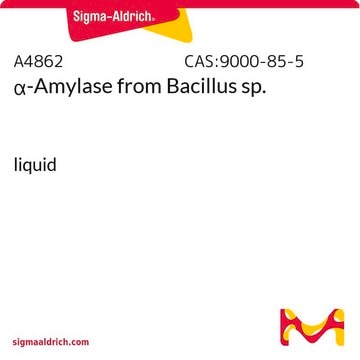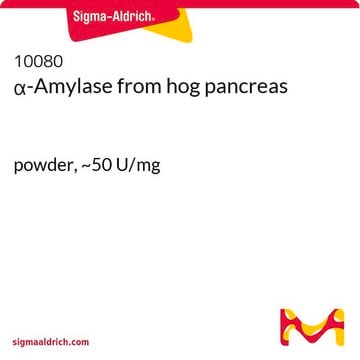This product is soluble in water. No additional calcium is required. For specific applications it may also be prepared in typical sodium or potassium phosphate buffer solutions.
10069
α-Amylase from Bacillus sp.
powder, yellow-brown, ~380 U/mg
Selecione um tamanho
R$ 825,00
Selecione um tamanho
About This Item
R$ 825,00
Produtos recomendados
fonte biológica
Bacillus sp.
Formulário
powder
atividade específica
~380 U/mg
características do produto alternativo mais ecológico
Waste Prevention
Design for Energy Efficiency
Learn more about the Principles of Green Chemistry.
sustainability
Greener Alternative Product
cor
yellow-brown
categoria alternativa mais ecológica
, Enabling
temperatura de armazenamento
2-8°C
Procurando produtos similares? Visita Guia de comparação de produtos
Categorias relacionadas
Descrição geral
Aplicação
- as a dispersal enzyme to test degradation of S. aureus biofilms[2],
- in the enzymatic hydrolysis of tapioca starch[3]
- in the enzymolysis of plant-based native and the amorphous granular starches[4]
Ações bioquímicas/fisiológicas
Definição da unidade
Palavra indicadora
Danger
Frases de perigo
Declarações de precaução
Classificações de perigo
Resp. Sens. 1
Código de classe de armazenamento
11 - Combustible Solids
Classe de risco de água (WGK)
WGK 1
Ponto de fulgor (°F)
Not applicable
Ponto de fulgor (°C)
Not applicable
Equipamento de proteção individual
dust mask type N95 (US), Eyeshields, Faceshields, Gloves
Escolha uma das versões mais recentes:
Já possui este produto?
Encontre a documentação dos produtos que você adquiriu recentemente na biblioteca de documentos.
Os clientes também visualizaram
-
In which solution I should to dissolve the alfa amylase? should had ca+2? (for starch degradation)
1 answer-
Helpful?
-
Active Filters
Nossa equipe de cientistas tem experiência em todas as áreas de pesquisa, incluindo Life Sciences, ciência de materiais, síntese química, cromatografia, química analítica e muitas outras.
Entre em contato com a assistência técnica












